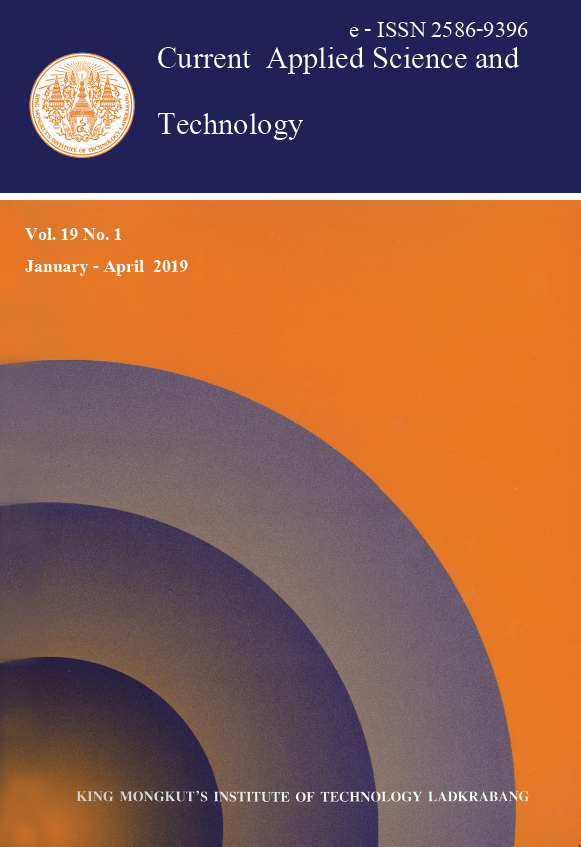Influence of Hydrothermal-carbonization Process on Biochar Properties from Cattail Weed Waste
Main Article Content
Abstract
Biochars have been successfully synthesized from Cattail leave (CL) via hydrothermal and carbonization process. The experimental work described has focused on physical properties of biochars produced from Cattail leaves at 160, 180 and 200°C for 8, 12 and 24 h for hydrothermal and substituted to carbonization at 700°C for 2 h. The influences of hydrothermal and carbonization on the pore structure, surface functional groups and the product yield was also investigated by characterization using Scanning Electron Microscope (SEM) and Fourier Transform Infrared Spectroscopy, respectively. Although the morphologies of cell structures were maintained in the hydrothermal and carbonization, it was found that the yield of produced biochar was decreased with increase of the hydrothermal temperature and time. The images from SEM showed that the pore structures are quite roughness on their external surface of biochar and the functional group of their surface area has most of pure carbon content (59-65 wt%).
Keywords: Cattail leaves; Carbonization; Hydrothermal; Biochar
Corresponding author: E-mail: apiluck.ei@kmitl.ac.th
Article Details
Copyright Transfer Statement
The copyright of this article is transferred to Current Applied Science and Technology journal with effect if and when the article is accepted for publication. The copyright transfer covers the exclusive right to reproduce and distribute the article, including reprints, translations, photographic reproductions, electronic form (offline, online) or any other reproductions of similar nature.
The author warrants that this contribution is original and that he/she has full power to make this grant. The author signs for and accepts responsibility for releasing this material on behalf of any and all co-authors.
Here is the link for download: Copyright transfer form.pdf
References
Devid, P., Scoot, H., 1986. Market Assessment of Biomass Gasification and Combustion Technology for Small- and Medium-Scale Applications: A national laboratory of the U.S. Department of Energy.
Satya Sai, P.M., Ahmed, J., 1997. Production of activated carbon from coconut shell char in a fluidized bed reactor. Industrial and Engineering Chemistry Research, 36 (9), 3625-3630.
Donni, A., Wan, M., Mohd, K., 2005. Prepration and characterization of activated carbon from palm shell by chemical activation with K2CO3. Bioresorce Technology, 98, 145-149.
Peter, M., 2001. Energy production from bimass (part 2) conversion technology. Bioresorce Technology, 83, 47-54.
Kacem, M., Pellerano, M., 2015. Pressure swing adsorption for CO2/N2 and CO2/CH4 separation: comparison between activated carbons and zeolites performances. Fuel Process Technology, 138, 271-283.
Liu, Z., Zhang, F.S., 2009. Removal of lead from water using biochars prepared from hydrothermal liquefaction of biomass. Journal of Hazardous Materials, 167, 933-939.
Liu, Z., Zhang, F.S., 2010. Characterization and application of chars produced from pinewood pyrolysis and hydrothermal treatment. Fuel, 89, 510-514.
Selvi, B.R., Jagadeesan, D., Suma, B., Nagashaniar, G., Arif, M., Balasubramanyam, K., Eswaramoorthy, M., Khudu, T.K., 2003. Intrinstically fluorescent carbon nanosphere as a nuclear targeting vector: delivery of membrane-impermeble molecule to modulate gene expression in vivo. Nano Letters, 8(10), 3182-3188.
Titirici, M., Antonietti, M., Thomas, A., 2006. A generalized synthesis of metal oxide hollow spheres using hydrothermal approach. Chemistry of Materials, 18(16), 3808-3812.
Sevilla, M., Fuertes, A., Mokaya,R., 2011.High density hydrogen storage in superactivated carbons from hydrothermally carbonizrd renewable organic materials. Energy and Enviromental Science, 4, 1400-1410.
Sevilla, M., Fuertes, A.B., 2011. A superior performance for carbon dioxide capture. Energy and Enviromental Science, 4, 1765-1771.
Faisal, A., Sahu, J.N., 2011. Optimization and characterization studies on bio-oil production from palm shell by pyrolysis using response surface methodology. Biomass and Bioenergy, 35, 3604-3616.
Chao, C., Wha-Seung, A., 2011. CO2 capture using mesoporous alumina prepared by a sol–gel process. Chemical Engineering Journal, 166, 646-651.
Sevilla, M., Macia-Agllo, J.A., Fuerest, A.B., 2011. Hydrothermal carbonization of biomass as a route for the sequestration of carbon dioxide chemical and structural properties of the carbonizaed products. Biomass and Bioenergy, 33, 3152-3159.
Kamimura, Y., Shimomura, M., Endo, A., 2016. CO2 adsorption–desorption properties of zeolite beta prepared from OSDA-free synthesis. Microporous and Mesoporous Materials, 219, 125-133.
Jarosław, S., Urszula, N., Antoni, W.M., Rafał, J.W., Beata, M., 2017. Highly microporous activated carbons from biomass for CO2 capture and effective micropores at different conditions. Journal of CO2 Utilization, 18, 73–79.
Berge, N.D., Ro, K.S., Mao, J., Flora, J.R.V., Chappell M.A., Bae, S., 2011. Hydrothermal carbonization of municipal waste streams. Environmental. Science and Technology, 45(13), 5696-5703.
Minkova, V., Razvigorova, M., Goranova, M., Ljutzkanow, L., Angelona, G., 1991. Effect of water vapor on the pyrolysis of solid fuel. Fuel, 71, 263-265.
Gergova, K., Galushko, A., Petrov, N., Minkova, V., 1992. Investrigation of the porous structure of activated carbons prepared by pyrolysis of agricultural by-products in a stream of water vapour.. Biomass and Bioenergy, 30, 721-730.
Dilek, A., 2013. Effect of pyrolysis temperature and heating rate on biochar obtained from pyrolysis of safflower seed press cake. Bioresource Technology, 128, 593-597.
Ayillath, K., Paresh, L., 2015. Lignin depolymerization into aromatic monomer over solid acid catalysts. ACS Catalysis, 5(1), 365-379.
Solum, M.S., Pugmire, R.J., Jagtoyen, M., Derbyshire, F., 1995. Evolution of carbon structure in chemically activated wood. Carbon, 33, 1247-1254.
Lu, C., Bai, H., Wu, B., Su, F., Hwang, J.F., 2008. Adsorption of Carbon Dioxide from Gas Streams via Mesoporous Spherical-Silica Particles. Energy and Fuels, 489-496.
Serafin, J., Narkiewicz, U., Morawski, A.W., Wróbel, R.J., Michalkiewicz, B., 2017. Standing out the key role of ultramicroporosity to tailor biomass-derived carbons for CO2 capture. Journal of CO2 Utilization, 230, 73-79.


